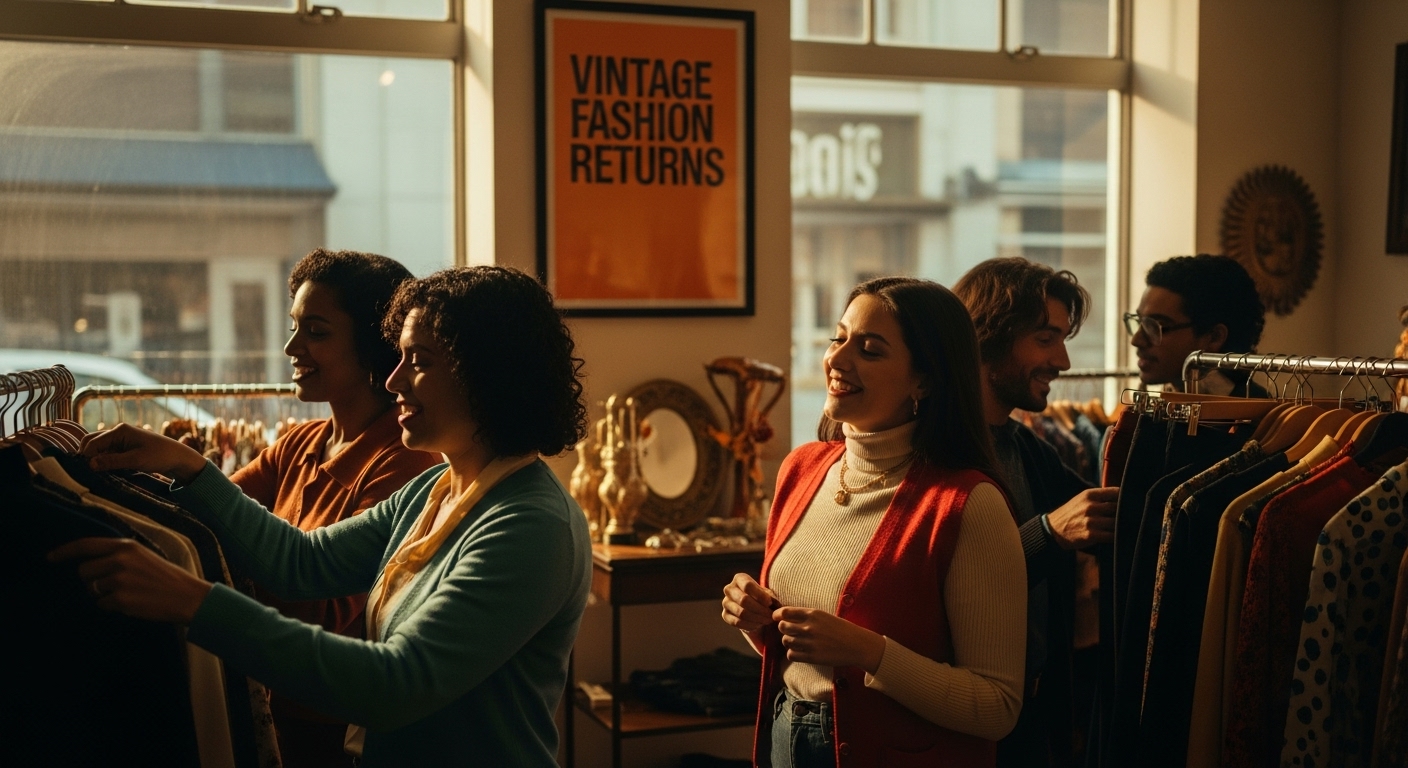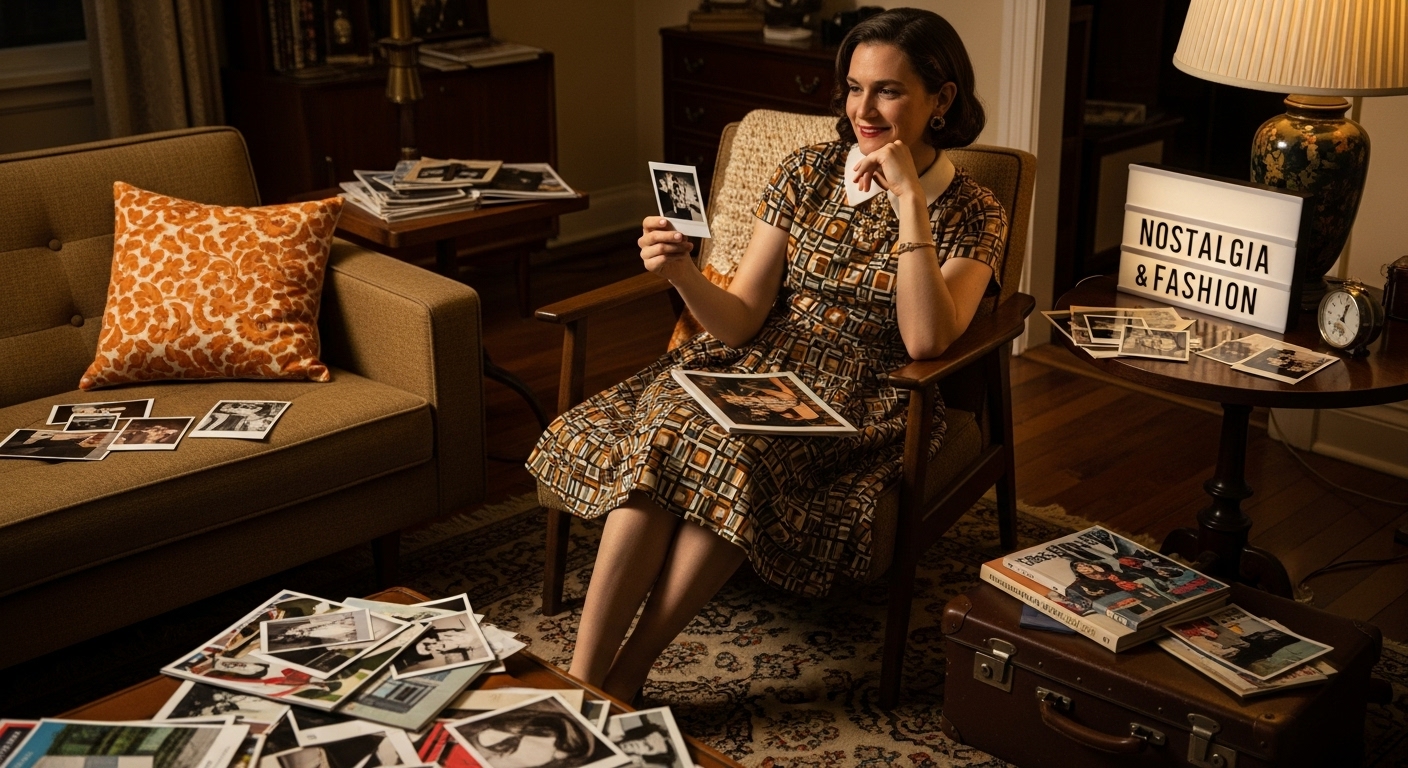Understanding Why Vintage Fashion Returns: A Deep Dive
- Emma

- Sep 23
- 8 min read

Vintage fashion is not just about looking unique. It is a living archive, filled with garments crafted using techniques and materials that tell stories from another era. Yet, here is something many overlook. Wearing vintage can cut your carbon footprint by up to 70 percent compared to buying new clothes. People assume vintage fashion is only about stylish nostalgia but its real power lies in how it connects craft, culture, and conscious living in one timeless choice.
Table of Contents
Quick Summary
Takeaway | Explanation |
Vintage fashion spans 1920s to 1980s | Vintage clothing originates from specific historical periods, specifically between the 1920s and 1980s, showcasing unique styles and craftsmanship. |
Understand the definition of vintage | Vintage fashion is defined as items created at least 20 years prior, distinguishing it from retro, antique, and secondhand garments. |
Vintage clothing reflects historical narratives | Each piece of vintage fashion tells its own story, revealing insights about societal norms, economic conditions, and cultural transformations of its time. |
Sustainable benefits of vintage shopping | Purchasing vintage significantly reduces textile waste and carbon emissions, promoting a more sustainable fashion consumption model. |
Social media fuels vintage fashion interest | Digital platforms have reshaped how vintage fashion is appreciated and shared, creating global communities and enhancing access to historical styles. |
Defining Vintage Fashion and Its Characteristics
Vintage fashion represents a complex and nuanced realm of clothing and style that transcends simple categorisation. At its core, vintage fashion encompasses garments and accessories originating from specific historical periods, typically spanning from the 1920s to the 1980s. Understanding the role of vintage in style reveals a rich tapestry of cultural expression and sartorial storytelling.
The Essential Definition of Vintage
According to research from Heriot-Watt University, vintage fashion is technically defined as clothing designed and produced at least 20 years before current fashion trends. This definition distinguishes vintage from other related terms like ‘retro,’ ‘antique,’ or ‘secondhand,’ which carry distinct connotations and historical significance.
The following table compares key fashion-related terms discussed in the article, clarifying what distinguishes vintage fashion from closely related concepts.
Term | Definition | Distinction from Vintage |
Vintage | Clothing and accessories made at least 20 years before current trends | Set period (typically 1920s-1980s) |
Retro | New items imitating styles from the past | Not original period pieces |
Antique | Items typically over 100 years old | Much older than vintage |
Secondhand | Any previously owned clothing, regardless of age | Age not a defining factor |
Key characteristics of genuine vintage fashion include:
Authentic historical construction techniques
Original materials and fabric compositions
Period-specific design elements
Craftsmanship reflecting the era’s manufacturing standards
Historical and Cultural Significance
Vintage fashion is not merely about old clothing but represents a profound cultural artifact. Each piece tells a narrative about societal norms, technological capabilities, and aesthetic preferences of its originating period. The garments serve as tangible historical documents, offering insights into design evolution, social movements, and cultural transformations.
Moreover, vintage fashion embodies sustainability long before environmental consciousness became mainstream. By preserving and reusing clothing from previous decades, vintage fashion enthusiasts actively participate in reducing textile waste and challenging the rapid consumption cycles of contemporary fashion industries.
Understanding vintage fashion requires recognising it as more than a trend—it is a celebration of craftsmanship, historical continuity, and individual expression.
The Cultural and Historical Significance of Vintage Fashion
Vintage fashion transcends mere clothing, functioning as a powerful narrative medium that captures societal transformations, cultural movements, and individual identities. Why vintage fashion matters reveals how these garments are more than aesthetic choices—they are living historical documents that reflect complex social dialogues.
Clothing as Cultural Artifacts
According to cross-cultural research from Heriot-Watt University, vintage fashion serves as a critical lens through which we can understand historical contexts. Each garment embodies the technological capabilities, social norms, and aesthetic sensibilities of its originating era.
Key cultural dimensions of vintage fashion include:
Representation of social movements
Reflection of economic conditions
Expression of gender and class dynamics
Documentation of technological innovations in textile production
Preserving Collective Memory
Vintage clothing acts as a tangible connection to collective memory, allowing contemporary individuals to experience and understand past experiences. These garments preserve narratives that might otherwise be lost—documenting everything from wartime rationing to counterculture movements, from industrial revolution manufacturing techniques to feminist fashion statements.
Moreover, vintage fashion challenges contemporary fast-fashion consumption by emphasising craftsmanship, durability, and individual expression. Each piece represents a moment frozen in time, inviting wearers to become storytellers and historians, bridging generational experiences through carefully preserved textiles.
In essence, vintage fashion is not simply about wearing old clothes, but about celebrating human creativity, resilience, and the intricate ways fashion reflects our evolving social landscape.
Sustainability: The Environmental Impact of Vintage Shopping
Vintage shopping represents a powerful strategy for reducing environmental impact within the fashion ecosystem.
The sustainability of vintage fashion offers an innovative approach to addressing the significant ecological challenges posed by contemporary clothing production.
Carbon Footprint and Textile Waste Reduction
According to research from the University College London and ReLondon, vintage shopping can dramatically reduce greenhouse gas emissions associated with clothing production. By extending the lifecycle of existing garments, consumers can potentially decrease textile waste and manufacturing demands.
Key environmental benefits of vintage shopping include:

Preventing clothing from entering landfill systems
Reducing demand for new textile production
Minimising water consumption in manufacturing
Lowering carbon emissions associated with clothing creation
Circular Economy and Sustainable Consumption
Vintage shopping embodies the principles of circular economy, transforming traditional linear consumption models. Instead of continuously producing new garments, vintage fashion promotes reuse, recycling, and preservation of existing textiles. This approach challenges the rapid, disposable nature of contemporary fashion industries by emphasising quality, durability, and long-term utility.
Moreover, each vintage purchase represents a direct intervention in the environmental impact of clothing production.
This table organises the key environmental benefits mentioned in the discussion of vintage fashion, offering a clear view of how vintage shopping supports sustainability goals.
Environmental Benefit | Description |
Textile waste reduction | Prevents clothing from contributing to landfill problems by extending garment life |
Lower carbon footprint | Considerably reduces greenhouse gas emissions compared to producing new clothing |
Reduced water consumption | Minimises water use associated with manufacturing new garments |
Decreased demand for new textile production | Lessens need for creating new fabrics and materials, which is resource-intensive |
Promotes circular economy principles | Encourages reuse, recycling, and prolongs the lifecycle of existing garments |
By choosing pre-existing garments, consumers actively reduce the demand for new textile manufacturing, which traditionally involves significant water usage, chemical treatments, and carbon emissions. |
Ultimately, vintage shopping is not merely a fashion choice but a profound environmental statement—a tangible method of practicing sustainable consumption and challenging wasteful production paradigms.
The Role of Social Media and Nostalgia in Vintage Resurgence
Social media and nostalgia have become powerful catalysts in reigniting interest in vintage fashion, transforming how individuals discover, appreciate, and consume historical clothing styles. The psychology behind vintage fashion fascination reveals a complex interplay between digital connectivity and emotional longing.
Digital Platforms and Vintage Community Building
According to research from the University of Manchester, digital platforms have fundamentally reshaped vintage fashion consumption. Online communities, particularly Instagram, TikTok, and dedicated vintage fashion blogs, provide unprecedented spaces for enthusiasts to share, learn, and celebrate historical clothing aesthetics.
Key digital influences on vintage fashion include:
Visual storytelling through curated vintage imagery
Democratisation of historical fashion knowledge
Global community formation across geographical boundaries
Instant sharing of restoration and styling techniques
Nostalgia as a Cultural Reconnection Mechanism
Nostalgia operates beyond mere sentimentality, functioning as a sophisticated psychological mechanism for cultural reconnection. By engaging with vintage fashion through social media, individuals construct personal narratives that bridge generational experiences.

This digital interaction allows people to reimagine and reinterpret historical styles, creating contemporary meanings from past aesthetic expressions.
Moreover, social media algorithms and aesthetic trends have accelerated vintage fashion’s visibility, making historical styles more accessible and desirable. Each shared vintage outfit becomes a potential viral moment, transforming personal fashion choices into broader cultural conversations about style, identity, and historical representation.
Ultimately, the convergence of social media and nostalgia has elevated vintage fashion from a niche interest to a dynamic, globally interconnected cultural phenomenon.
Buying Vintage: Key Considerations for Modern Shoppers
Purchasing vintage clothing requires a nuanced approach that balances aesthetic appreciation, historical understanding, and practical considerations. Understanding what makes clothing truly vintage becomes crucial for making informed purchasing decisions.
Authentication and Quality Assessment
According to UK government guidance on purchasing second-hand goods, consumers must prioritise safety and authenticity when acquiring vintage items. Professional vintage shoppers develop sophisticated skills for evaluating garment quality, including examining fabric composition, construction techniques, and potential restoration requirements.
Key evaluation criteria for vintage clothing include:
Fabric integrity and potential wear
Original manufacturing techniques
Condition of seams and stitching
Presence of original labels or maker’s marks
Potential alteration or repair history
Ethical and Sustainable Purchasing Strategies
Modern vintage shopping transcends mere acquisition, representing a conscious commitment to sustainable fashion consumption. Shoppers increasingly seek pieces that not only reflect personal style but also minimise environmental impact. This approach involves carefully selecting items with longevity, understanding their historical context, and appreciating the craftsmanship that distinguishes vintage garments from contemporary mass-produced clothing.
Moreover, successful vintage shopping requires developing a discerning eye for quality, understanding sizing variations across different historical periods, and being prepared to invest time in potential restoration or tailoring. Each vintage piece represents a unique narrative, demanding patience and appreciation for its individual journey through time.
Ultimately, buying vintage is an art form that combines historical knowledge, personal aesthetics, and a commitment to sustainable fashion practices.
Experience the Revival of True Vintage Fashion with My Vintage
Are you inspired by the historical depth and unique individuality that vintage fashion celebrates, yet find it challenging to access genuinely authentic pieces? This article has explored how timeless style, sustainability, and nostalgia drive the ongoing return of vintage fashion, but turning knowledge into action can often feel overwhelming. Problems like identifying real vintage, making ethical choices, and finding high-quality garments from decades past can hold you back from curating a wardrobe with real character.

See how My Vintage solves these challenges. Our platform is dedicated to offering hand-picked, original vintage clothing and accessories that match everything discussed in the article, from historical construction to sustainable purchasing. Whether you are seeking statement pieces or want to adopt a more eco-friendly wardrobe, discover our exclusive vintage collections today. Step into a world where history meets style and make your mark by shopping truly authentic vintage fashion now.
Frequently Asked Questions
What defines vintage fashion?
Vintage fashion refers to clothing and accessories that originated from specific historical periods, typically from the 1920s to the 1980s, and is defined as items designed and produced at least 20 years prior to current trends.
Why is vintage fashion considered sustainable?
Vintage fashion promotes sustainability by extending the lifecycle of existing garments, reducing textile waste, and challenging the rapid consumption cycles of contemporary fashion industries, thereby lowering carbon emissions associated with clothing production.
How does social media influence the popularity of vintage fashion?
Social media platforms have reshaped vintage fashion consumption by creating online communities where enthusiasts can share, learn, and celebrate historical aesthetics, making vintage styles more visible and desirable.
What should I consider when purchasing vintage clothing?
When buying vintage clothing, it’s essential to authenticate items, assess their quality, and consider their historical context. Shoppers should examine fabric integrity, original manufacturing techniques, and the potential need for restoration or tailoring.
Recommended






Comments